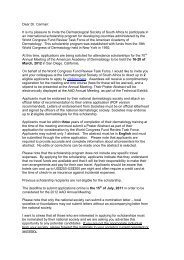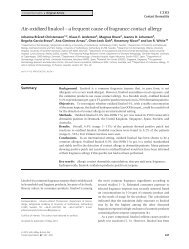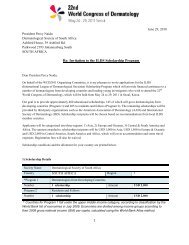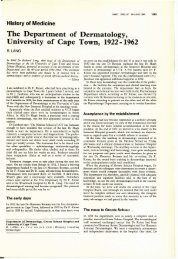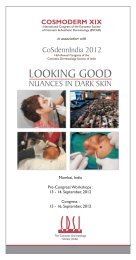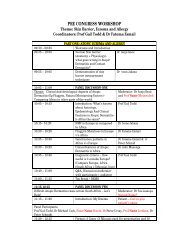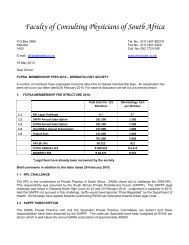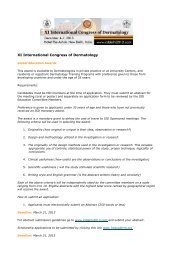Guidelines on the Management of Atopic Dermatitis ... - Dermatology
Guidelines on the Management of Atopic Dermatitis ... - Dermatology
Guidelines on the Management of Atopic Dermatitis ... - Dermatology
You also want an ePaper? Increase the reach of your titles
YUMPU automatically turns print PDFs into web optimized ePapers that Google loves.
Delayed eczematous food allergy reacti<strong>on</strong>s<br />
The diagnosis <strong>of</strong> delayed eczematous reacti<strong>on</strong>s is more difficult than <strong>the</strong> diagnosis <strong>of</strong><br />
immediate reacti<strong>on</strong>s. In such cases specific IgE and skin prick tests may not correlate with<br />
<strong>the</strong> presence or absence <strong>of</strong> a delayed food reacti<strong>on</strong>. In <strong>the</strong>se cases an eliminati<strong>on</strong>reintroducti<strong>on</strong><br />
diet is <strong>the</strong> <strong>on</strong>ly reliable way <strong>of</strong> determining whe<strong>the</strong>r or not a food is a trigger.<br />
Such diets must be d<strong>on</strong>e under supervisi<strong>on</strong> <strong>of</strong> a dietician. If patients resp<strong>on</strong>d to any dietary<br />
interventi<strong>on</strong>, it is highly recommended that <strong>the</strong> food should be reintroduced to c<strong>on</strong>firm <strong>the</strong><br />
diagnosis. This may be a formal food challenge in hospital in <strong>the</strong> presence <strong>of</strong> any<br />
sensitisati<strong>on</strong> or history <strong>of</strong> immediate reacti<strong>on</strong>s to <strong>the</strong> food(s), or a home<br />
challenge/reintroducti<strong>on</strong> in <strong>the</strong> absence <strong>of</strong> sensitisati<strong>on</strong> or a history <strong>of</strong> <strong>on</strong>ly delayed<br />
symptoms. If a formal food challenge is performed for atopic dermatitis, <strong>the</strong> schedule may<br />
need to be prol<strong>on</strong>ged to observe <strong>the</strong> patient for up to six hours after <strong>the</strong> maximum dose for<br />
immediate and intermediate reacti<strong>on</strong>s. It is important to review <strong>the</strong> patient at 24 hours for<br />
scoring to formally document delayed-type worsening <strong>of</strong> atopic dermatitis. In cases <strong>of</strong><br />
prol<strong>on</strong>ged avoidance <strong>of</strong> a food, it is recommended to perform SPT or ImmunoCAP tests in<br />
patients prior to reintroducti<strong>on</strong> <strong>of</strong> <strong>the</strong> food – even in cases where <strong>the</strong>re has not been a<br />
history <strong>of</strong> any immediate reacti<strong>on</strong>s and such a challenge should be performed under<br />
c<strong>on</strong>trolled circumstances.<br />
The process <strong>of</strong> eliminati<strong>on</strong>-rechallenge testing involves: 20<br />
<br />
<br />
<br />
<br />
<br />
Removing all sources <strong>of</strong> <strong>the</strong> suspected food or foods for four to six weeks to bring<br />
about an improvement in <strong>the</strong> atopic dermatitis. If <strong>the</strong> atopic dermatitis does not<br />
improve within four weeks, it is unlikely that food allergy is a relevant trigger and oral<br />
food challenges are not necessary. In this case a normal diet should resume<br />
immediately.<br />
Even if <strong>the</strong> atopic dermatitis has resolved, foods should be reintroduced sequentially to<br />
assess for a return (or worsening) <strong>of</strong> <strong>the</strong> atopic dermatitis, prior to ascribing <strong>the</strong><br />
improvement to <strong>the</strong> exclusi<strong>on</strong> diet. This is because <strong>the</strong> improvement may be<br />
coincidental or reflect a placebo effect. C<strong>on</strong>comitant <strong>the</strong>rapies and o<strong>the</strong>r envir<strong>on</strong>mental<br />
factors should not be changed during <strong>the</strong> period <strong>of</strong> assessment for food allergies. In<br />
additi<strong>on</strong>, if multiple foods have been excluded it is imperative to see which <strong>of</strong> <strong>the</strong>se<br />
foods is truly resp<strong>on</strong>sible and exclude <strong>on</strong>ly those foods, while allowing <strong>the</strong> return <strong>of</strong><br />
n<strong>on</strong>-c<strong>on</strong>tributory foods into <strong>the</strong> diet.<br />
Food reintroducti<strong>on</strong> may be performed as a standard food challenge with a single food<br />
in incremental doses. If <strong>the</strong>re is no immediate reacti<strong>on</strong>, <strong>the</strong>n give <strong>the</strong> food for three to<br />
four days successively and m<strong>on</strong>itor atopic dermatitis scores daily. In selected cases a<br />
home challenge may be performed.<br />
Should <strong>the</strong> skin not react to <strong>the</strong> introducti<strong>on</strong> <strong>of</strong> this food, challenge with a new food<br />
every three to four days.<br />
However, should <strong>the</strong> food exacerbate <strong>the</strong> atopic dermatitis, it should now be<br />
c<strong>on</strong>sidered a causal food allergen and be removed from <strong>the</strong> diet to bring about <strong>the</strong><br />
improvement in <strong>the</strong> symptoms for <strong>the</strong> sec<strong>on</strong>d time.<br />
Removing foods from <strong>on</strong>e‟s diet requires support and educati<strong>on</strong>, especially in cases where<br />
<strong>the</strong> food is comm<strong>on</strong> and present in many hidden sources. A dietician must be c<strong>on</strong>sulted to<br />
ensure <strong>the</strong> allergen is completely eliminated from <strong>the</strong> diet, as well as to provide alternatives<br />
to ensure nutriti<strong>on</strong>al adequacy <strong>of</strong> <strong>the</strong> residual diet.<br />
The natural history <strong>of</strong> food allergy resoluti<strong>on</strong> is variable and may differ in those with and<br />
without atopic dermatitis. It varies between allergens, with milk, egg, soy and wheat<br />
resolving earlier, and more comm<strong>on</strong>ly than allergies to peanuts or tree nuts. 31 Allergy to fish<br />
and shellfish, which more comm<strong>on</strong>ly develops later, may be life-l<strong>on</strong>g. In atopic dermatitis,



